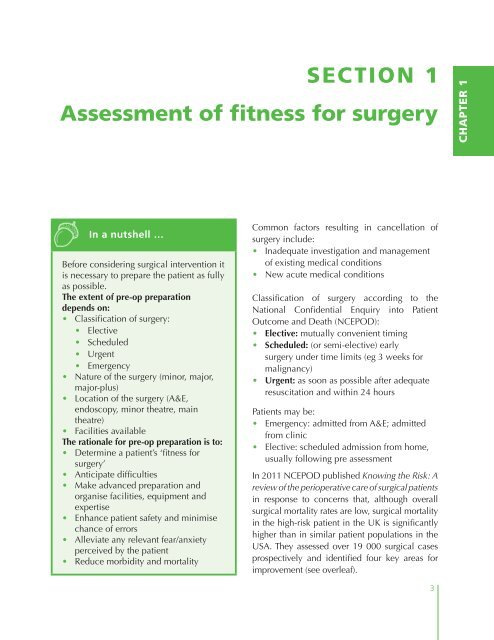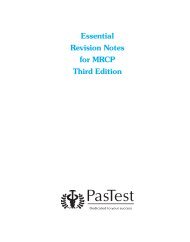MRCS PART A ESSENTIAL REVISION NOTES BOOK 1 - PasTest
MRCS PART A ESSENTIAL REVISION NOTES BOOK 1 - PasTest
MRCS PART A ESSENTIAL REVISION NOTES BOOK 1 - PasTest
- No tags were found...
You also want an ePaper? Increase the reach of your titles
YUMPU automatically turns print PDFs into web optimized ePapers that Google loves.
SECTION 1Assessment of fitness for surgeryCHAPTER 1In a nutshell …Before considering surgical intervention itis necessary to prepare the patient as fullyas possible.The extent of pre-op preparationdepends on: Classification of surgery: Elective Scheduled Urgent Emergency Nature of the surgery (minor, major,major-plus) Location of the surgery (A&E,endoscopy, minor theatre, maintheatre) Facilities availableThe rationale for pre-op preparation is to: Determine a patient’s ‘fitness forsurgery’Anticipate difficultiesMake advanced preparation andorganise facilities, equipment andexpertiseEnhance patient safety and minimisechance of errorsAlleviate any relevant fear/anxietyperceived by the patientReduce morbidity and mortalityCommon factors resulting in cancellation ofsurgery include: Inadequate investigation and managementof existing medical conditions New acute medical conditionsClassification of surgery according to theNational Confidential Enquiry into PatientOutcome and Death (NCEPOD): Elective: mutually convenient timing Scheduled: (or semi-elective) earlysurgery under time limits (eg 3 weeks formalignancy) Urgent: as soon as possible after adequateresuscitation and within 24 hoursPatients may be: Emergency: admitted from A&E; admittedfrom clinic Elective: scheduled admission from home,usually following pre assessmentIn 2011 NCEPOD published Knowing the Risk: Areview of the perioperative care of surgical patientsin response to concerns that, although overallsurgical mortality rates are low, surgical mortalityin the high-risk patient in the UK is significantlyhigher than in similar patient populations in theUSA. They assessed over 19 000 surgical casesprospectively and identified four key areas forimprovement (see overleaf).3
















